Delve into the spiritual symbolism of cover in the Bible, uncovering layers of protection, sacrifice, and divine relationship that beckon deeper exploration.

Cover in the Bible
Throughout the pages of the Bible, the concept of cover is so omnipresent it almost forms the fabric of every single narrative. You've likely skimmed over mentions of coverings, from the garments of Eden that clothed Adam and Eve, to the protective embrace of the Ark. Yet, beneath these layers, there's a profound spiritual symbolism waiting for you to uncover.
Whether it's the protective coverings, sacrificial coverings, or even the Veil in the Temple, each serves as a thread in the larger tapestry of redemption and relationship between humanity and the divine. Let's explore how these themes of cover weave through biblical narratives, revealing insights into God's character and His interactions with mankind.
Key Takeaways
- Coverings in the Bible symbolize purity, divine presence, and protection, reflecting a deep spiritual significance.
- Garments and ark designs illustrate themes of divine protection, stewardship, and the importance of obedience in preservation.
- Ritualistic coverings and sacrifices embody the concepts of atonement, redemption, and the cost of sin, emphasizing the need for divine mercy.
- The tearing of the veil signifies a new covenant, removing barriers between God and humanity, with Jesus' role central to this transformation.
The Garments of Eden

In examining the Garments of Eden, it's crucial to understand how they symbolize a transformative shift in human self-perception and divine interaction. This narrative isn't merely about the transition from nudity to clothing; it encapsulates a profound reconfiguration of humanity's relationship with divinity and self-awareness. Initially, garden nudity represented an unblemished existence, devoid of shame and self-consciousness. This purity wasn't just physical but reflected an unbroken communion between the divine and the human.
The Serpent's deceit, however, catalyzed a catastrophic shift. By succumbing to the serpent's words, the first humans didn't just disobey a divine command; they plunged into a new consciousness brimming with shame, guilt, and vulnerability. This newfound awareness wasn't merely psychological; it was existential, reshaping their interaction with the divine and their environment.
The garments provided by the divine, then, weren't just coverings for physical nakedness. They were symbols of a complex, multifaceted reality that humanity had entered into—a reality marked by the loss of innocence and the beginning of human history as a saga of divine-human interaction characterized by mercy, judgment, and the promise of redemption. These garments underscored the gravity of the fall while simultaneously offering a form of grace, a tangible reminder of divine compassion amidst the consequences of human actions.
Therefore, in the narrative arc of human-divine relations, the Garments of Eden stand as a poignant symbol of the shift from an idyllic existence to one of moral and spiritual complexity.
Protection in the Ark

You'll observe that the Ark's divine design not only symbolizes divine protection but also underscores the importance of divine instruction in ensuring safety amidst chaos.
Noah's faithful obedience to these divine directives is paramount in navigating the destruction, highlighting the interplay between human faith and divine provision.
Ark's Divine Design
While examining the Ark's construction, it becomes evident that its design wasn't only functional but divinely orchestrated to ensure unparalleled protection. This divine blueprint, often explored through artistic interpretations, showcases a remarkable blend of material properties and spiritual significance.
- Material Properties: The choice of gopher wood and pitch for waterproofing reveals a deep understanding of durability and preservation.
- Dimensions: Precise measurements ensured stability and capacity.
- Compartments: Designed for optimal organization and survival of diverse species.
- Ventilation System: Ingeniously planned to provide fresh air and light.
- Door Placement: Symbolically significant and practical for boarding and sealing.
Analyzing these elements, you'll appreciate the Ark's design as a testament to divine foresight, blending physical properties with spiritual purpose, far beyond mere survival.
Noah's Faithful Obedience
Exploring the Ark's divine design leads us naturally to consider Noah's faithful obedience, a cornerstone of the Ark's protection and purpose. His unwavering commitment to God's directives not only ensured the safety of his family but also exemplified a profound level of animal stewardship. By gathering species into the Ark, Noah preserved biodiversity, acting as a steward of God's creation.
This act of obedience was later affirmed by the establishment of the rainbow covenant, symbolizing God's promise never to destroy the earth with a flood again. Noah's adherence to divine commandments, therefore, is crucial in understanding the Ark's role as a vessel of salvation. It highlights the importance of faith and obedience in achieving divine protection and fulfilling God's will.
Humanity's New Beginning
Within the protective confines of the Ark, humanity embarked on a new beginning, safeguarded from the deluge that wiped clean the slate of creation. This moment symbolizes not just a divine intervention but also a critical lesson on environmental stewardship for ancient civilizations and modern societies alike.
- Preservation of Species: Demonstrates early understanding of the importance of biodiversity.
- Environmental Stewardship: Highlights the need for responsible management of natural resources.
- Renewal: Offers a metaphor for the regeneration and renewal of Earth.
- Human Responsibility: Emphasizes humanity's role in protecting and preserving creation.
- Ancient Wisdom: Reflects ancient civilizations' awareness of human-environment dynamics.
Analyzing this narrative sheds light on the timeless lesson of coexisting harmoniously with our environment, underscoring the imperative of environmental stewardship.
The Passover Lamb
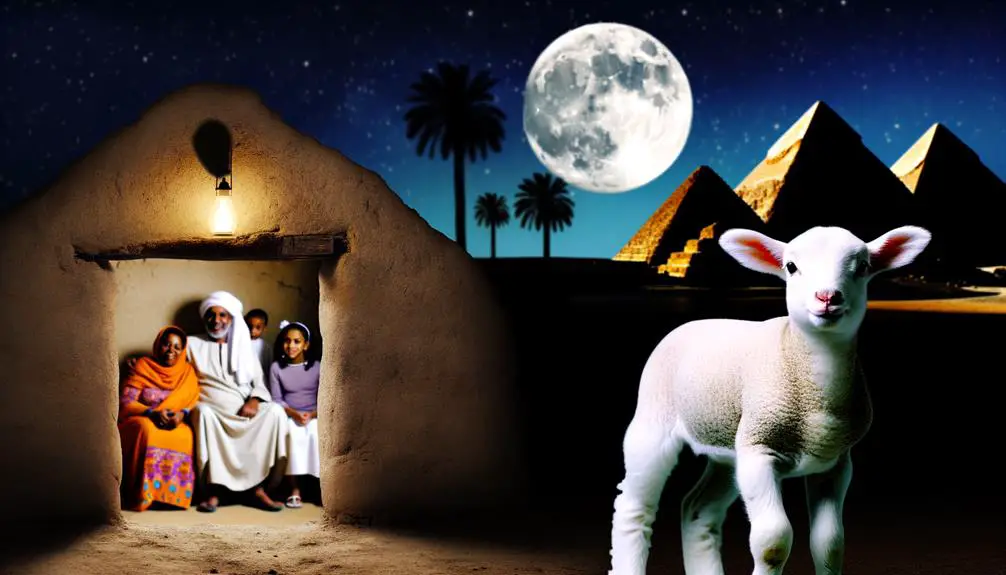
As you explore the concept of 'The Passover Lamb' within biblical texts, it's crucial to examine the rich symbolism of the lamb, which stands at the heart of Passover rituals. These ceremonies, deeply embedded in Jewish tradition, offer insight into themes of redemption and deliverance that resonate throughout the scripture.
Symbolism of the Lamb
In biblical symbolism, the lamb, notably the Passover Lamb, embodies innocence and redemption, serving as a foundational element in understanding sacrificial practices and their deeper theological implications. The lamb's innocence and its sacrificial significance offer rich layers of meaning in scriptural narratives, highlighting themes of salvation and divine provision.
- Lamb's Innocence: Represents purity, making it an ideal sacrificial offering.
- Sacrificial Significance: Underlines the cost of atonement and redemption.
- Redemption Symbol: The lamb as a metaphor for deliverance from sin.
- Covenant Relationship: Signifies the bond between the divine and the faithful.
- Prophetic Fulfillment: Points to future messianic expectations within biblical prophecy.
Analyzing the symbolism of the lamb deepens understanding of its role in conveying complex religious concepts, underscoring the interplay between divine justice and mercy.
Passover Rituals Explained
Building on the symbolic significance of the lamb, exploring the Passover rituals reveals how these practices encapsulate themes of liberation and divine intervention.
Central to these rituals is the consumption of unleavened bread and bitter herbs, each element rich with meaning. Unleavened bread, or matzah, symbolizes the Israelites' haste in leaving Egypt, lacking time for their bread to rise. It's a tangible reminder of the swift transition from slavery to freedom. Bitter herbs, on the other hand, signify the bitterness of slavery, enhancing the ritual's reflective nature.
Together, these elements, alongside the Passover lamb, create a multifaceted ritual that not only commemorates historical deliverance but also invites participants to ponder the depths of bondage and the exhilaration of liberation.
Redemption and Deliverance
The Passover lamb emerges as a pivotal symbol of redemption and deliverance, encapsulating the profound liberation of the Israelites from Egyptian bondage. This act not only signifies the physical freedom of a nation but also embodies the spiritual journey from sin's consequence to the forgiveness process.
- Sin's Consequence: The Passover lamb illustrates the gravity of sin and its repercussions.
- Substitutionary Sacrifice: Represents the lamb taking on the consequences meant for the sinner.
- Divine Forgiveness: Showcases God's willingness to forgive through a process.
- Liberation from Bondage: Not just physical but spiritual emancipation.
- Covenant Relationship: Reinforces the bond between the divine and humanity through redemption.
This narrative underscores the intricate connection between divine provision, human obedience, and the eternal pursuit of holiness.
Coverings of the Tabernacle
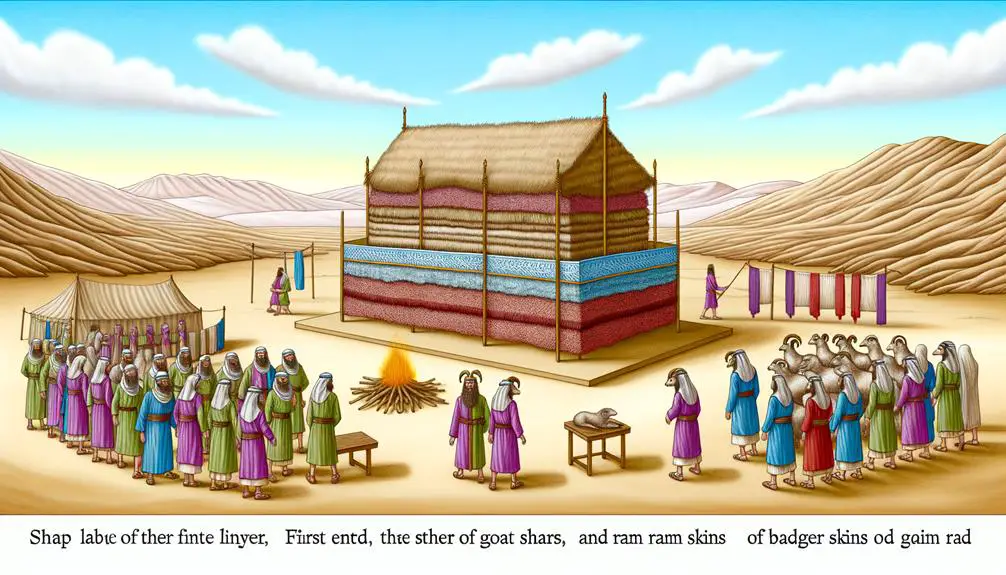
Exploring the coverings of the Tabernacle reveals intricate details about their symbolic significance and practical function in ancient worship practices. The coverings, meticulously described in the Hebrew Bible, weren't merely functional; they held profound material significance and showcased exceptional craftsmanship details. Made from materials like fine linen, goat hair, and skins of sea cows, each layer contributed to the sanctity and splendor of this mobile sanctuary.
You'll notice that the innermost covering, crafted from fine twisted linen and adorned with cherubim, symbolizes the purity and divine presence dwelling within the Tabernacle. This layer's craftsmanship details—colors, embroidery, and design—reflect an unparalleled devotion to creating a space worthy of divine inhabitation. The subsequent layers, including goat hair, provided additional protection and were symbolic of atonement, reinforcing the Tabernacle's role in the Israelites' spiritual life.
The outermost coverings, made from durable skins, weren't only practical, protecting the inner sanctum from the elements, but also served as a constant reminder of the Tabernacle's sanctity and the need for separation from the profane. The choice of materials and the meticulous attention to detail in the construction of these coverings underscored their importance in facilitating a sacred space where the divine and the human could meet.
Through this analysis, it's evident that the coverings of the Tabernacle weren't mere physical structures. They embodied a deeper spiritual significance, reflecting the Israelites' understanding of holiness, atonement, and the presence of the divine amidst their community.
Atonement and Sacrifices
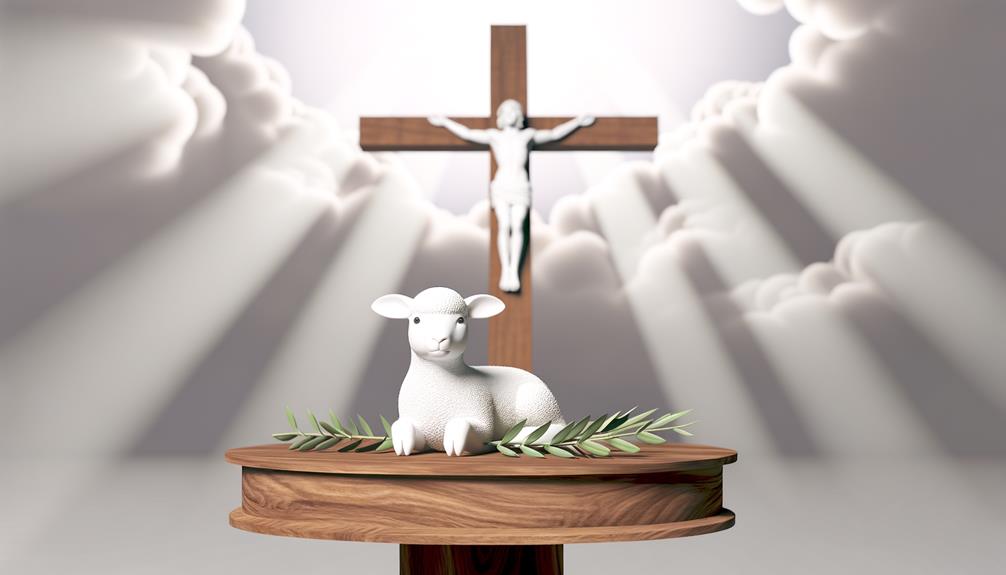
Within the context of ancient Israelite worship, atonement and sacrifices played pivotal roles, embodying the community's efforts to maintain a harmonious relationship with the divine. These practices were deeply rooted in the understanding of humanity's sin nature and the necessity for ritual purification to approach God. The sacrificial system, as outlined in the Torah, served not only as a means of expiation for sin but also as a tangible expression of repentance and devotion to God.
The complex rituals and offerings prescribed for various transgressions and occasions highlight a sophisticated theological framework that recognized the multifaceted nature of sin and purity. These practices underscored the Israelites' recognition of their need for divine grace and mercy. Here are five key aspects to consider when analyzing atonement and sacrifices in ancient Israelite religion:
- Sin nature: Acknowledgment of humanity's inherent propensity to sin necessitated a means for reconciliation with God.
- Ritual purification: The process of becoming ritually clean was essential for participation in the religious community and for approaching the divine.
- Blood sacrifice: Central to the atonement process, symbolizing life given to atone for the life marred by sin.
- Day of Atonement (Yom Kippur): The holiest day in the Jewish calendar, dedicated to atonement and repentance.
- Substitutionary atonement: The principle that an innocent life could bear the sins of the guilty, reflecting the gravity of sin and the depth of God's mercy.
Understanding these components sheds light on the profound spiritual and communal significance of atonement and sacrifices in maintaining a covenant relationship with God.
Cloaks of Healing and Authority
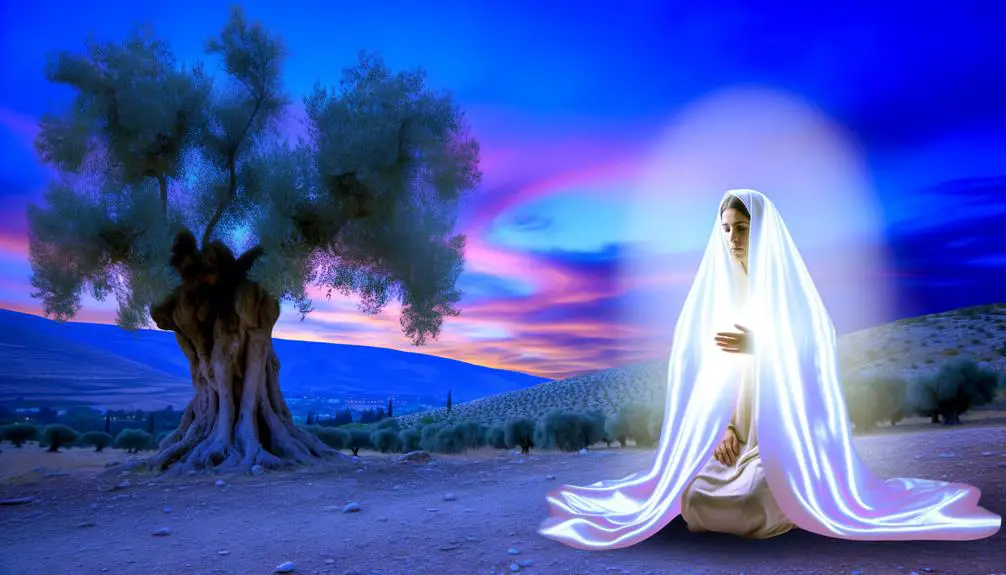
In biblical narratives, cloaks often symbolize healing and authority, reflecting the profound interplay between divine power and human interaction. These garments aren't mere articles of clothing but carry deep theological and symbolic weight. The robe significance in the Bible is multifaceted, embodying themes of identity, mission, and divine favor.
The mantle symbolism, in particular, is richly layered. For instance, when Elijah passes his mantle to Elisha, it's not just a transfer of a physical object but a conveyance of prophetic authority and spiritual inheritance. This act underlines the mantle's role as a symbol of succession and empowerment within the biblical tradition. Similarly, the cloak of Jesus becomes a source of healing when a woman suffering from bleeding touches it and is immediately healed. This story doesn't just highlight the cloak's connection to healing but also illustrates Jesus' authority over illness and his willingness to extend his power to those who reach out in faith.
These narratives underscore a broader biblical theme: cloaks aren't only protective coverings but also signify greater realities. They're imbued with the power to heal, to confer authority, and to symbolize divine commissioning. This dual role of cloaks — as both physical garments and carriers of deeper meaning — invites readers to reflect on the ways divine power manifests in tangible forms within the scriptures.
Understanding the robe significance and mantle symbolism within the Bible enriches one's appreciation of these texts, revealing how objects we might consider mundane can carry extraordinary spiritual and theological weight.
Veil Torn Asunder
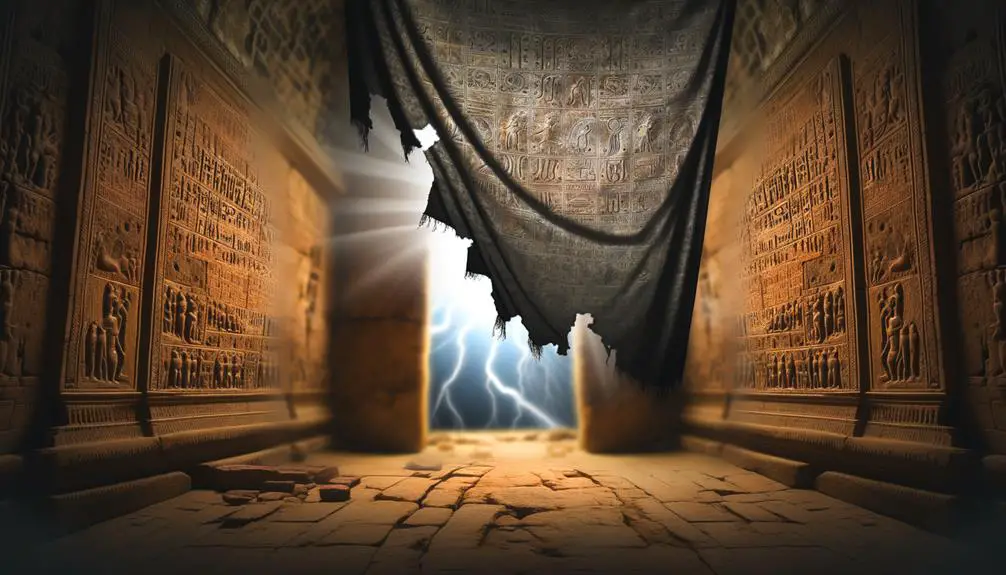
Shifting focus to another profound biblical moment, the tearing of the veil in the temple marks a significant theological event, symbolizing direct access to God previously mediated by priests and sacrifices. This event underscores a pivotal shift in the understanding of spiritual access and the temple's significance in religious practices. The veil, once a barrier between the Holy of Holies and the rest of the temple, served as a physical and symbolic separation between God and humanity. Its destruction at the moment of Jesus' death is rich in meaning and implications for believers.
To grasp the depth of this occurrence, consider the following points:
- Temple Significance: The temple was the center of Jewish worship and sacrifice. The Holy of Holies, where the veil was located, was the most sacred area, accessible only to the high priest once a year.
- Spiritual Access: The tearing of the veil symbolizes the removal of barriers between God and humanity, granting believers direct access to the divine.
- New Covenant: This event signifies the establishment of a new covenant, where sacrifices and intermediaries are no longer necessary for reconciliation with God.
- Universal Priesthood: Symbolizes the belief in the priesthood of all believers, indicating that all followers have the right and responsibility to commune directly with God.
- Eternal Sacrifice: Emphasizes Jesus' role as the ultimate sacrifice, making further sacrifices redundant for achieving spiritual closeness with God.
Analyzing the tearing of the veil offers profound insights into the evolving relationship between the divine and the devout, highlighting a transformative moment in spiritual understanding and access.
Frequently Asked Questions
How Does the Concept of "Cover" Reflect the Relationship Between God and Humanity Outside of the Context of Physical Garments or Structures?
You're exploring how 'cover' symbolizes the connection between God and humanity beyond physical realms. This concept showcases divine intimacy, where God's protection extends over humans in a spiritual sense, enveloping them in care and guidance.
It also highlights spiritual vulnerability, suggesting that humans are open and exposed before the divine, needing that 'cover' for safety and nurturing.
Analyzing this, you delve into an area where faith and divine care intertwine, offering a profound perspective on spiritual connection.
Are There Any Parables or Teachings by Jesus That Indirectly Discuss the Idea of "Cover" Without Explicitly Mentioning Garments or Shelters?
You're diving into how Jesus's parables touch on 'cover' through themes like 'Seed growth' and 'Light darkness', without mentioning garments or shelters.
Consider the Parable of the Mustard Seed; it illustrates growth and protection within God's kingdom, akin to a cover. Similarly, the discourse on light and darkness underscores uncovering truth and enlightenment.
These teachings subtly convey covering's essence—protection, growth, and revelation—without explicitly discussing physical coverings.
How Has the Symbolism of "Cover" Evolved in Christian Theology and Practice Beyond the Biblical Narratives Mentioned?
In exploring how cover symbolism has morphed within Christian theology, you'll find its theological evolution fascinating. Initially rooted in concrete biblical narratives, this concept now embraces broader, more abstract meanings.
It signifies protection, salvation, and the embracing presence of the divine. As Christian thought and practice evolved, the metaphorical 'cover' has deepened, reflecting not just physical protection but also spiritual safeguarding and communal identity within the faith.
Can the Theme of "Cover" Be Connected to Modern-Day Spiritual Practices or Rituals Within the Christian Community That Are Not Directly Related to the Specific Biblical Instances Cited?
You're stepping into a realm where faith weaves protection into the fabric of daily life.
In modern Christian practices, the theme of 'cover' crystallizes as covering prayers and donning spiritual armor.
These rituals, although not directly springing from specific biblical narratives, echo the ancient call for divine protection and guidance.
Analytically, they represent a continuity of faith's shield, evolving to meet contemporary spiritual needs while rooting in timeless theological ground.
How Do Different Christian Denominations Interpret the Metaphorical Significance of "Cover" in Their Doctrines, Especially in Aspects Not Covered by the Traditional Stories of Garments, Protection, and Atonement?
You'll find that Christian denominations vary in interpreting 'cover's' metaphorical significance, especially beyond traditional narratives. Some see it through covenant symbolism, viewing cover as a divine promise or protection. Others focus on divine concealment, interpreting cover as God's way of shielding or hiding for a purpose.
This analysis shows a deep, layered understanding of 'cover,' reflecting diverse theological perspectives and teachings within the Christian community.
Conclusion
In exploring the motif of coverings within the Bible, you've traversed from Eden's garments to the torn veil of the temple. Remarkably, each layer symbolizes protection, atonement, and divine presence, revealing a profound narrative of redemption.
This isn't mere coincidence; it's a meticulously woven tapestry, illustrating that through various forms of covering, humanity is offered a pathway back to divine communion. Analyzing these symbols, you uncover a deeper understanding of theological concepts, enriching your spiritual and scholarly pursuits.



Sign up